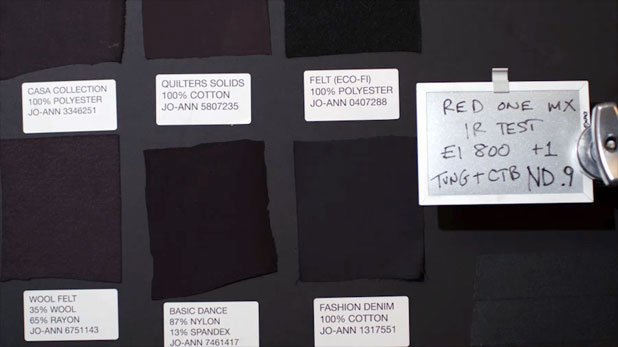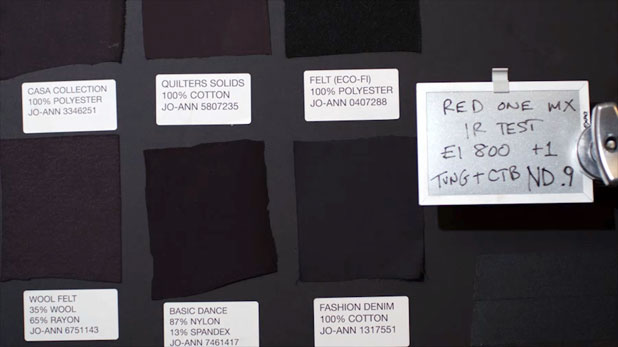
RED says that their new sensor is more resistant to IR contamination than their original sensor. This test shows that, while there may be an improvement, IR is still an issue. Fortunately all the usual IR filter solutions work just fine.
As every filter manufacturer profiled here has, at one time or another, given me filters to test and then let me keep them, I’m not going to tell you which filters I think work the best. I’m going to let the pictures speak for themselves.
First, some notes about the test:
(1) The daylight and tungsten tests were shot under tungsten lighting to ensure a full spectrum hot source. The tungsten source (a small Chimera containing a Tota-lite) was covered with full CTB for the daylight tests.
(2) The camera was set at EI 800 but with Flut set at +1 to reduce the EI to 400, which is probably where I’m going to rate the MX when I shoot with it. The effective EI was 400.
(3) I white balanced every clip using the color picker in Red-Cine X and selected the top left label on the chart.
(4) As Red-Cine X didn’t always do a consistent job of white balancing I exported the clips to ProRes4444, brought them into Final Cut Pro and white balanced again using the color picker on FCP’s three-way color corrector.
(5) I then output the results to a Quicktime file encoded using the Animation codec, to avoid H.264 gamma problems, and then converted that file into the MP4 that you’ll be viewing using Adobe Media Encoder.
The filters tested were:
Daylight (tungsten plus CTB):
(1) No filter
(2) ND .30
(3) ND .60
(4) ND .90
(5) ND .90 plus Tiffen Hot Mirror
(6) ND .90 plus Tiffen IR Hot Mirror (combination of Tiffen Hot Mirror and Tiffen T1)
(7) ND .90 plus Schneider 750
(8) ND .90 plus Formatt Hot Mirror
(9) ND .90 plus Schneider 680 (not on the market, and vignettes horribly, but cuts IR better than anything else and is a great control)
Tungsten:
(1) No filter
(2) ND .30
(3) ND .60
(4) ND .90
(5) ND .90 plus Tiffen Hot Mirror
(6) ND .90 plus Tiffen IR Hot Mirror
(7) ND .90 plus Schneider 750
(8) ND .90 plus Formatt HM
(9) ND .90 plus Schneider 680
(10) ND .90 plus Tiffen 80D Hot Mirror
(11) ND .90 plus Tiffen 80C Hot Mirror
I’ve put the video in its own space in order to show it at the largest resolution PVC allows, which is with a width of 900 pixels. At smaller sizes color contamination from the PVC color scheme can skew the results. Note that IR pollutes both the red and blue color channels: red wins under daylight, but blue edges slightly ahead of red under tungsten light.
With all that said, click the link to view the test results and make up your own mind.
NOTE: It has been pointed out to me that the “+1” on the slate seems to indicate a Flut level of +1, which would indicate ISO 1600. Rather I used it to indicate that I was overexposing one stop from ISO 800, and not as an indication of Flut setting.
Thanks to Adam Wilt for his assistance and the use of his RED ONE MX for this test.
Art Adams is a director of photography who rarely sees (infra) red. His website is at www.artadams.net.

Filmtools
Filmmakers go-to destination for pre-production, production & post production equipment!
Shop Now













